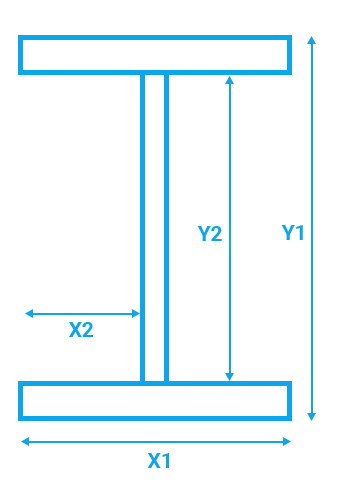Quickly determine the weight of I-Beams for construction projects with our accurate calculator. Great for builders and architects.
In the world of engineering and construction, accurate calculations are crucial, especially when it comes to determining the weight of structural elements like I sections.
The I section metal weight calculator plays a pivotal role in providing quick and precise measurements, aiding engineers, architects, and metalworkers in their projects.
An I section, also known as an I-beam or H-beam, is a common and widely used structural shape in construction and engineering. Its distinctive cross-sectional shape resembles the letter "I" and consists of two horizontal flanges connected by a vertical web.
I sections are renowned for their strength and versatility, making them an integral component in the design of various structures, from buildings and bridges to industrial frameworks.
If you want to calculate the volume of the I-section using the provided dimensions (outer and inner edge dimensions), you can use the formula:
Where,

This formula calculates the volume of the I-section by subtracting the area of the inner rectangle (representing the web) from the area of the outer rectangle (representing the overall shape of the I-section) and then multiplying by the length.
You can use this formula with the provided dimensions to accurately determine the volume of the I-section for your engineering or construction needs.
Let's consider a practical example of a 1-meter-long I-section with the following dimensions:
outer edge width (X1) of 60 mm (0.060 m),
outer edge height (Y1) of 80 mm (0.080 m),
inner edge width (x2) of 25 mm (0.025 m),
and inner edge height (y2) of 40 mm (0.040 m).
The volume of the I-section is then calculated as:
V = [(0.060×0.080)−2×(0.025×0.040)]×1 = 0.0028 m³
Consequently, the mass of the I-section can be determined using the formula
mass = density × volume
Assuming a density of 7900 kg/m³:
mass = 7900×0.0028 = 22.12 kg
This systematic approach enables the accurate calculation of the mass of an I-section, accommodating variations in dimensions.
Gather Information: Collect I-beam dimensions, including length, flange width, flange thickness, web depth, and web thickness.
Calculate Cross-sectional Area: Determine the cross-sectional area of the I-beam.
Calculate Volume: Multiply the cross-sectional area by the length to obtain the volume.
Determine Density: Identify the material density, commonly steel.
Apply the Formula: Multiply the volume by density to calculate the weight.
Units: Ensure consistent units (e.g., meters, millimeters, kilograms) for accurate results.
It's important to note variations in standard sizes and profiles for I-beams, and consideration of the specific material used, as different materials have distinct densities.
Online calculators simplify this process, providing users with an estimated weight. Always adhere to engineering standards and seek professional advice for safe and compliant structural design.
I sections are popular due to their excellent strength-to-weight ratio, providing stability and support in various structural applications.
Consider factors such as load-bearing requirements, span length, and material strength when selecting an I section for your project. Consulting with a structural engineer is advisable.
Yes, the calculator is versatile and can accommodate various materials by adjusting the density (ρ) in the formula.
Yes, standard dimensions are available for I sections, but custom sizes can also be fabricated based on project-specific requirements.